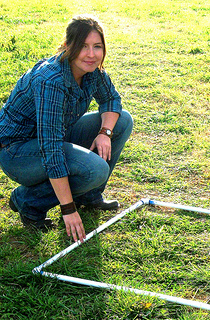
Q: For those of us who don’t know the history of fire suppression and the importance of controlled burns, could you outline the role of burns in ecosystems?
A: Fire plays a vital role in many North American ecosystems. The fire regime of an area controls the structure and community composition of natural systems, influences ground-water infiltration and runoff rates, structures resources available to wildlife species, and plays a role in nutrient cycling. It also controls plant pathogens that can kill forests and crops, increases productivity in agricultural systems, and determines landscape pattern, which creates a diverse array of species habitats.
A focus on fire suppression in the United States lasting almost a century has altered the fire regimes in many ecosystems. The goal of eliminating all wildfires from the landscape has proven impossible and has resulted in many unforeseen negative consequences. In many cases, fire suppression leads to a forest structure and composition that is more prone to invasion by non-native species, insect and pathogen outbreaks, and more intense and destructive wildfires.
Prescribed fire is a cost-effective tool for range and forest restoration and management. It allows managers to impose a fire regime tailored to their management objectives. It can be used to reduce fuel loads to prevent catastrophic wildfires, restore productivity to rangeland by managing encroaching shrubs, and reduce forest densities—effectively lowering risk of pathogen transmission.
Q: In your experience working with prescribed burns, why do you believe they are one of the more effective ways of maintaining rangeland ecosystems?
A: There is always risk, but with the proper infrastructure for support and training of prescribed burners, potential for damage and injury can be substantially reduced. This is important because changes in climate and land management, including fire suppression, are leading to encroachment of rangelands by woody plants throughout North America. Encroachment reduces livestock production, threatening the sustainability of this nearly $80 billion industry. Other management options for dealing with encroachment are not always available to land managers. Herbicide and mechanical brush removal is cost prohibitive, especially given the necessity of repeat application. They also do not provide the additional benefits that fire can, such as cycling nutrients and promoting heterogeneous landscapes that foster diversity.
Q: There are clear incentives for ranchers to regenerate grasslands for the health of their land and cattle. What is holding them back?
A: There are many reasons why landowners choose not to use prescribed fire to manage woody plant encroachment despite its advantage. Many ranchers lack equipment and expertise to carry out burns over large areas. Others are not aware of the benefits it provides or are uncertain that it will allow them to achieve their management objectives. While burn associations and landowner outreach can reduce these limitations, there are still complex social constraints that limit prescribed burning. Most states have regulations that ban the use of prescribed fire when fire danger is high. This can limit the time available to burners to conduct fires. Brush reduction often requires managers to burn under conditions that produce high-intensity fires. Burn prohibitions during these periods limit the effectiveness of prescribed fire for brush reduction. In addition to regulatory restrictions, prescribed burners are subject to legal liability for damage or injury caused by escaped prescribed fires. In many areas, landowners cite fear of escape and attendant liability concerns as the major impediment to prescribed burning.
Q: Do you believe that more ranchers would prescribe burns on their land if the liability risk aspect was not so high?
A: The effects of statutory reform on landowner behavior are not known. While the language of the prescribed burning acts state that they were enacted to encourage the use of prescribed fire, it is uncertain that the reforms are achieving their intended purpose. Hopefully my research will provide insight into this. I aim to determine the effectiveness of gross negligence rules and regulatory reforms for promoting prescribed burning by comparing private land prescribed fire use in states with different liability standards and regulations.
A more complete understanding of the consequences of burning laws is an important step in overcoming legislative constraints on the effective management of forests and rangelands with prescribed fire.
For more information on PERC’s Graduate Fellowship, click here.


